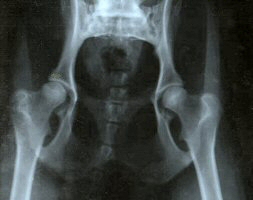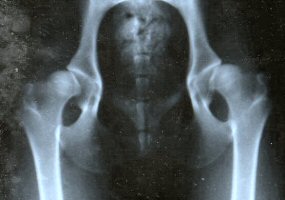
Health Testing
In many countries, especially those in Europe, it is compulsory to health test boxers prior to breeding. Ronin Boxers' breeding stock is carefully tested for soundness of hips, elbows and heart. They are some of the most thoroughly tested boxers in New Zealand. Where possible we also health test puppies in pet homes to indicate how our breeding program is progressing overall. We encourage puppy owners to keep us up to date with any puppy health issues.
Health testing won't guarantee that all puppies will be free from problems, but it greatly increases the chances of getting healthy puppies.
All Ronin boxers are carefully health tested making use of new testing technology as it becomes available. Some tests (like holter monitoring) we perform on all dogs including those retired from breeding but some (such as DNA) may be most useful on current breeding stock. Please view an individual dog's page for specific information on which tests they have had.
Hip Scoring
 |
 |
|||
X Ray showing joints yielding a good hip score. The balls (femoral heads) fit tightly into deep, rounded sockets (acetabulae). |
X Ray showing joints yielding a poor hip score. The balls (femoral heads) fit loosely into wide, open sockets (acetabulae). |
Hip dysplasia is a partial dislocation of the ball joint resulting in lameness when dogs are severely affected. It is largely inherited, so can only be reduced by testing and careful selection of breeding stock. Both boxer parents should have test scores less than 14.89, which is the average for the breed in New Zealand. However, positive results from the parents do not guarantee low scores for all their puppies, but the risk of problems is much less than if the parents are not tested. As part of a long term breeding plan, as many dogs as possible in a line should be tested to establish a significant average score. Dogs must be over 12 months old before they can be tested.
Heart Testing
There is more than one way to test a boxer's heart for problems that could be genetic. When a breeder says a boxer is heart tested it is important to understand which tests have been done and what the results imply.
Cardiac Auscultation - To ensure accuracy this test needs to be performed by a certified canine cardiologist. It involves listening to the dog's heart with a stethoscope to identify and locate any murmurs. Heart murmurs are an aspect of several of the main cardiac conditions boxers are prone to, such as: sub-aortic stenosis (SAS), pulmonic stenosis and mitral valve disease. It is also sometimes possible to detect the arrhythmia in more severe cases of boxer cardiomyopathy (BCM). Murmurs are graded on a scale of zero to six, with zero being free of murmurs and six being severe. It is ideal for a boxer to be graded zero, but a grade of one is also acceptable for breeding. When a higher grade is detected, the test should be followed up by a doppler test. Auscultation testing should be carried out by specialists because general vets may be unfamiliar with the test thresholds for each grade of murmur.
Doppler Echocardiography - This is an ultrasound scan of the heart that allows a specialist to detect the abnormal flow velocities associated with SAS. It can be used as the primary test or a follow up to an auscultation test.
Electrocardiogram (ECG) - The ECG is used to detect electrical conduction abnormalities over a period of five to ten minutes. An ECG is not a satisfactory way to detect BCM as the irregularities seen in this condition often appear in "runs" and are unlikely to appear in such a short period of time. So it is not reliable enough to use as a pre-breeding heart test.
Holter Monitoring - The Holter Monitor provides an ECG over an extended period and so is far more reliable than a brief ECG. The usual duration of a test is 24 hours. There is still a risk that a boxer with a Holter score of zero could have BCM. However, the risk is much smaller than the risk from a dog with an ECG score of zero. Conversely, a highly favourable score from the Holter Monitor indicates a far greater chance of a good heart condition than that suggested by equivalent ECG score. It is recommended that this test is repeated annually throughout the life of the dog to gain as much data as possible in order to make better informed breeding choices.
Degenerative Myelopathy
In degenerative myelopathy (DM) the dog's immune system breaks down the sheath lining the spinal column in some animals seven years old or older. It stops the brain from communicating with the lower body causing the dog to lose balance, drag one or both hind legs and become incontinent. In time it may extend to the front of the body eventually attacking the nerves going to the brain and so disrupting breathing. The rate of onset varies from two or three months to some years. Recently it has found to be associated with a genetic mutation of the SOD1 gene in at least 15 breeds of dogs including boxers. A high proportion of dogs in the most affected breeds have the mutation.
A DNA test is now available through the Orthopaedic Foundation for Animals - www.OFFA.org. It identifies dogs that are:
1) clear, having 2 normal copies of the gene, the dog is unaffected by this condition,
2) carriers, having one normal copy of the gene and one mutated copy of the gene, the dog is unaffected by this condition, and
3) are at much higher risk for developing DM, having 2 mutated copies of the gene. Though having two mutated copies of the gene does not necessarily result in disease.
| Home | News | Dogs | Puppies | Information | Downloads | Contact |
Designed by: Blue Kingfisher Web Design
© 2006-2017 Ronin Boxers